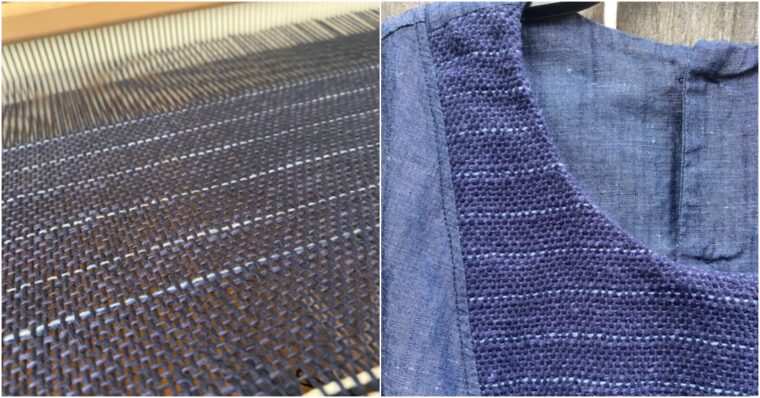For years I’ve been dreaming of owning a rigid-heddle loom and in 2020 I finally broke down and bought one. After weaving scarves, dishcloths and napkins, I realized that, if I was going to do this weaving thing, I was going to have to figure out how to mesh it with my love of garment sewing.
My loom width is only 24”, which limits the size of pattern pieces I can make. But after looking through some different versions of the Cinema Dress pattern, I loved the idea of using a different fabric for the yoke. I was overjoyed when I
found that the yoke pattern piece was a perfect width for my loom!
Next came the process of choosing yarn for the woven yoke, and finding fabric for the rest of the dress. I decided on a lovely dark indigo chambray. I knew that I wanted the yoke to stand out a little bit, but not too much. And to keep the yoke piece from being too thick, I needed to use a thinner yarn.
I started out trying a linen/cotton blend yarn by Gist Yarn in a dark indigo and light blue for both the warp and weft. I struggled with the tension on two attempts (I am a new weaver after all). I found success on my third try, using a dark indigo cotton for the warp and saving the linen/cotton blend for the weft.
The scariest part of this whole process was cutting into my handwoven fabric. After gathering my courage to cut out the front yoke piece, I found I had enough for the welt pocket pieces, too.
I will be honest that this pattern can feel a little overwhelming as you get started. There are lots of pattern pieces and since this is a longer dress, they are large pattern pieces. But as with all Liesl + Co. patterns, the pattern directions are simple and clear and if you take your time, everything comes together easily. The pattern comes with instructions for altering the bust area, but fortunately I didn’t need to make these alterations.
I cut out a size 10 and did not need to make any alterations. Design-wise, I opted for a shorter skirt piece, and I didn’t topstitch the yoke. I did not put the v-notch into the neckline as the patter suggests, and left the neckline rounded instead. I knew that the thickness of the handwoven fabric might make it difficult for the notched neckline to lay nicely.
There are a few things I would do differently when sewing this pattern again. I’ve started finishing my seams with my serger prior to piecing them together, but for this pattern, I didn’t do it. This wasn’t really a major deal until I got to the side panels and the pockets. I wish that I had finished the edges of all four pocket pieces and the side panels prior to stitching them together. It was super-hard to do this after I had sewn them all and I don’t have the clean finish on the inside that I would have if I had serged them first.
(Speaking of sergers, I’ve recently started using my serger to gather my fabric and man, what a different it makes. I did that for the skirt pieces and the sleeves and I’m so crazy happy with how it turned out, compared to when I try to gather with basting stitches. If you have a serger, I highly encourage you to figure out the settings for your machine and give it a whirl!)
I will say that this dress at times reminds me of something out of the 1700s (maybe I’ve been watching too much Outlander), but it also sort of screams “homeschool mom” (which I actually am). I knew when I chose the chambray it was risky, but overall I am happy with how this dress turned out. Every time I look at the front yoke piece I’m so excited (and sort of in awe, honestly) that I made that fabric. I haven’t made a dress like this for a really long time and it’s so lovely to put it on and give a twirl.

